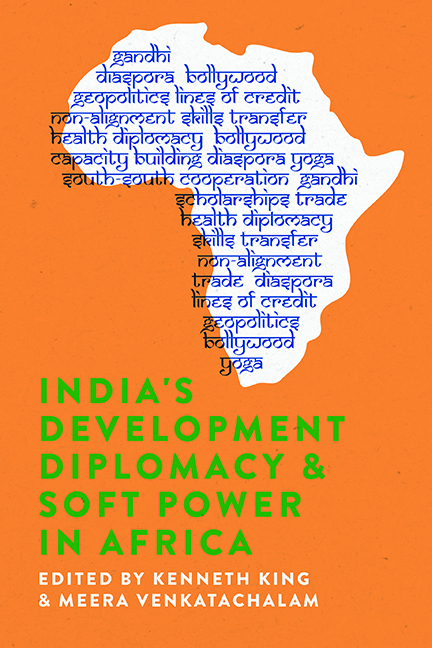Book contents
- Frontmatter
- Contents
- Notes on Contributors
- Acknowledgements
- List of Abbreviations
- Glossary
- Introduction: India–Africa Now: Changing Imaginaries and Knowledge Paradigms
- Part 1 The Geopolitical Imaginary and Soft Power
- Part 2 The Indian Political Right and the Reconfiguration of Soft Power in Africa
- Part 3 Capacity Building: Shifting Modalities and New Knowledgescapes
- Part 4 Skilling, Knowledge Transfer and Indo-African Interactions
- Conclusion: Reflections on India–Africa Studies, Development Cooperation and Soft Power
- Index
6 - A Shining Example: Modelling Growth in India's Pan-African e-Network
Published online by Cambridge University Press: 26 May 2022
- Frontmatter
- Contents
- Notes on Contributors
- Acknowledgements
- List of Abbreviations
- Glossary
- Introduction: India–Africa Now: Changing Imaginaries and Knowledge Paradigms
- Part 1 The Geopolitical Imaginary and Soft Power
- Part 2 The Indian Political Right and the Reconfiguration of Soft Power in Africa
- Part 3 Capacity Building: Shifting Modalities and New Knowledgescapes
- Part 4 Skilling, Knowledge Transfer and Indo-African Interactions
- Conclusion: Reflections on India–Africa Studies, Development Cooperation and Soft Power
- Index
Summary
‘We’re a nation of a billion people and our thought is: “What can I give to the world?”’ explained Dr Abdul Kalam when we met in his Rajaji Marg residence in New Delhi, in March 2011. ‘We can give knowledge. We can remove the pain of the people. That is that type of culture we have,’ continued Kalam. The former president of India then recalled how it all began. It started with his presidential visit to South Africa, in September 2004, when he was attending a session of the Pan-African parliament in Johannesburg. All of the African nations were represented, Kalam remembered. In his inaugural address, he engaged the audience with what he described as a vision: ‘Then the idea came in. How to connect them. Our hospitals and the African hospitals, our universities and the African universities, how we can connect? And when I presented, they cheered.’
Five years after Kalam's visit to South Africa, the Pan-African e-Network was launched. The Pan-African e-Network (which I will now refer to as ‘PAN’) provided tele-education and telemedicine services between 2009 and 2017. This chapter focuses on the telemedicine component of the network, which connected hospitals in over forty African countries with twelve tertiary care hospitals located in Indian metropolises. To do so, I draw upon field research carried over the past decade, and most intensively in 2010–12, when I conducted interviews and field observations in India, as well as in Dakar (Senegal) and Addis Ababa (Ethiopia).
Right from the design stage, PAN was an exceptionally ambitious project, relying on a large network infrastructure. Its implementation involved laying out a transnational network, composed of a fibre-optic section (connecting sites in India), undersea cables (connecting India and Africa) and satellite technology (connecting sites in Africa). PAN's telemedicine operations depended on dozens of doctors, and also on engineers, mostly of Indian origin, dispatched to the connected sites – including all participating hospitals, a data centre (New Delhi) and a satellite hub station (Dakar, Senegal). It also involved the importation, set up and maintenance of medical and computer equipment that was provided as part of the project. PAN was funded by the Indian government under the budget of the Ministry of External Affairs (MEA), with substantial annual operating costs.
- Type
- Chapter
- Information
- India's Development Diplomacy and Soft Power in Africa , pp. 121 - 134Publisher: Boydell & BrewerPrint publication year: 2021

